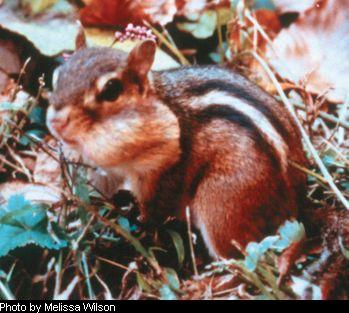

WILDLIFE DIVERSITY NOTEBOOK: Common Name: Eastern chipmunk Latin Name: Tamias striatus (from the Latin word striatus meaning furrow-a reference to the stripes down their back) Description: Chipmunks are small ground-dwelling rodents.
They have characteristic markings that make them easy to distinguish from
other members of the squirrel family. Two white stripes, one above and
one below the eye, adorn the short, round head. Five black lines stripe
the back: two on each side, separated by a white or buff band, which contains
the fifth black stripe, down the middle of the back. The ears are short,
rounded and held erect. The flattened tail is well haired, blackish above,
rust below, and fringed in white or gray. Both sexes are alike in color
and size, measuring 8-1/2 to 9-1/2 inches long and weighing 2-1/2 to 4
ounces. Their front feet are adapted for holding and eating food while
sitting upright. The front teeth are chisel-shaped, a characteristic of
all rodents. Habitat: Chipmunks inhabit deciduous (hardwood) forests where there
is a thick vegetative understory and old logs or stone ledges. In
open stands with little or no cover, chipmunks are most often found
on rocky hillsides and living in crevices of stone walls. They are
frequently seen in parks and around gardens and lawns. Natural History: Chipmunks seem more common than other members of the rodent order because they are diurnal (active during the day). Most activity, however, takes place during the cooler hours of the morning and afternoon. Excessive heat and inclement weather will hamper normal activities. These rodents are highly aggressive toward intruders, and readily defend the immediate area around their den entrance. Their defense is more vocal than violent. You have probably heard the chipmunk’s loud “chuck, chuck, chuck” call. Chipmunks rarely climb trees except to escape predators or to gather food. They spend almost their entire lives in an area usually less than a half-acre. Travel of 75 yards or greater from the den is considered exceptional. The outer fringes of individual home ranges often overlap with other chipmunks. Except during the breeding season, chipmunks are solitary, living in separate dens. Predators of chipmunks include hawks, minks, raccoons, weasels, martens, foxes, bobcats, coyotes, red squirrels, cats and large snakes. In their natural habitat, chipmunks compete with and complement the natural community of plants and animals. They compete with gray, red and flying squirrels, grouse, deer, turkeys, mice and other mast-eating animals for food. When chipmunks leave excessive amounts of food stored in the ground
there is perhaps less for other wildlife, but forest tree species
are regenerated when these stored seeds sprout. Chipmunks have specially adapted internal cheek pouches that allow them to carry large amounts of food at one time. These pouches are used when caching food for winter consumption and are emptied by squeezing them with their front feet. On occasion, they eat food on the spot, often at a favorite stump or rock that becomes littered with broken nut shells and fruit seeds. Much time is spent in late summer and fall gathering and storing nuts and other seeds for the winter. When not occupied with food-gathering or territorial defense, chipmunks sleep in their underground burrows. Burrow entrances are neat round holes, usually two inches or less in diameter. They are often located under a rotten log, stump or rock. From the entrance, the burrow plunges straight down for a few inches and then descends more gradually until it levels out at a depth of about three feet. During burrow excavation, soil is carried away from the entrance in cheek pouches used to carry food. Because of this, there is little or no evidence of excavated material from the subterranean burrow system. Within four or five years, an average chipmunk’s burrow may be extended to a length of 30 feet, have several openings, and may contain up to six chambers. In late October or November, chipmunks retire to their dens, plugging
up the entrance hole. Although they are not true hibernators, some
may sleep for long periods of time during the cold winter months.
They store food rather than fat, and must wake up often to eat. Mild
weather during mid-winter may entice them out of their dens for short
periods of time. Breeding: Chipmunks emerge to breed in late February and early March. There are two breeding seasons annually. During the spring season, the older females, yearlings and females born the previous summer season will breed. During the summer season, late July to August, yearlings that did not mate in spring and a few of the three-month-old females may also breed. Older females may produce two litters per year. Most young are sexually mature at age one. After a 31-day gestation period, usually four or five young are born. Young chipmunks are blind and naked at birth. They spend a month in the burrow system before leaving the den. Range: They are common from Quebec south to Florida and west to Louisiana and North Dakota . Chipmunks are enjoyable to watch, but when they move into an urban setting they may conflict with man’s interest. They dig up garden seeds and have been accused of snitching flower bulbs. Chipmunks get into camps and homes on occasion and can cause limited structural damage. Burrow entrances in lawns, rock gardens, stonewalls and near foundations may also be objectionable. In many instances, however, any disturbance is offset by the pleasing antics of these alert animals. Factsheet prepared by the DNR Wildlife Diversity Program staff.
|
